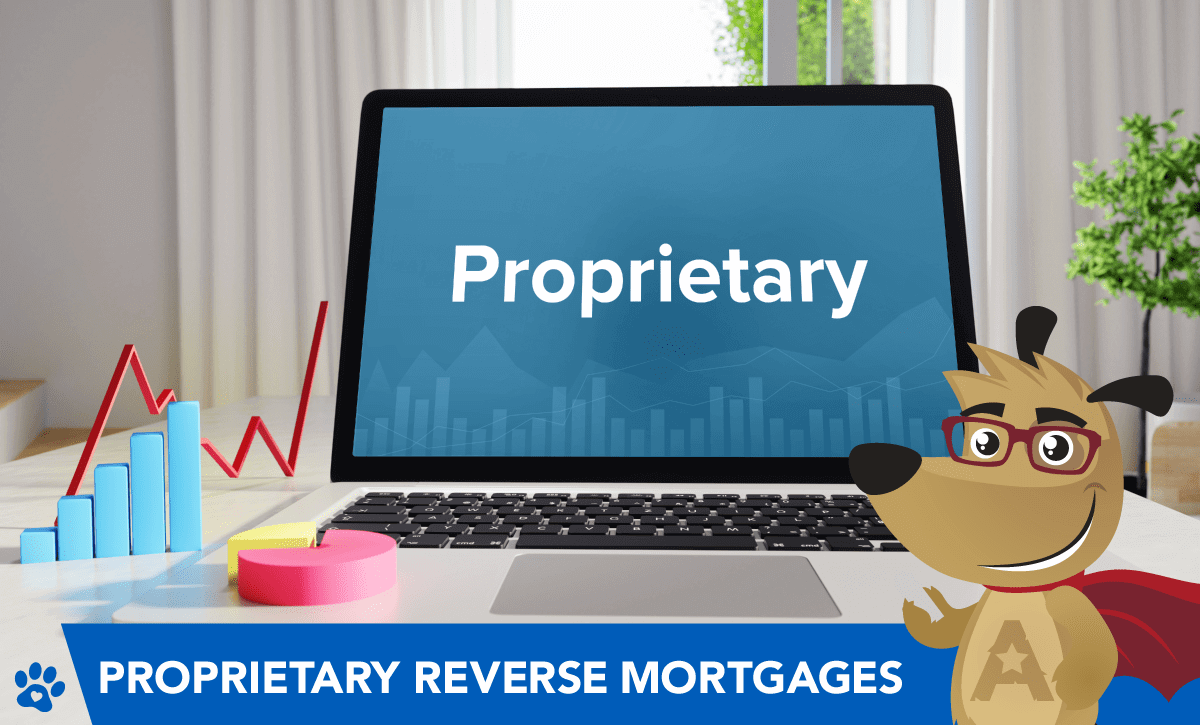
Proprietary Reverse Mortgages

 |
ARLO™REVERSE MORTGAGE
ASSISTANT |
Proprietary Reverse Mortgage vs. HECM: Which Is Right for You?
 |
Michael G. Branson, CEO of All Reverse Mortgage, Inc., and moderator of ARLO™, has 45 years of experience in the mortgage banking industry. He has devoted the past 20 years to reverse mortgages exclusively. (License: NMLS# 14040) |
 |
All Reverse Mortgage's editing process includes rigorous fact-checking led by industry experts to ensure all content is accurate and current. This article has been reviewed, edited, and fact-checked by Cliff Auerswald, President and co-creator of ARLO™. (License: NMLS# 14041) |
Are you considering a reverse mortgage but unsure about the differences between a Home Equity Conversion Mortgage (HECM) and a proprietary reverse mortgage? You’ve come to the right place.
In this guide, we’ll cover:
- What a proprietary reverse mortgage is
- When a proprietary reverse mortgage might be better than a HECM
- Qualifications for a proprietary reverse mortgage
- How the costs compare to a HECM
Whether you’re a homeowner looking to maximize your financial options, a family member helping a loved one, or simply curious about the benefits of proprietary reverse mortgages. This guide is designed to provide you with clear, straightforward information to help you make the best choice for your situation.

2025 Update: How HUD’s New HECM Rules Shift the Game
-
HECM lending limit raised: HUD increased the Maximum Claim Amount (MCA) to $1,249,125 for 2025 (HUD Mortgagee Letter 2024-22). That means more homeowners can now stay within the HECM program without turning to a proprietary product solely for size.
-
Eligibility tightened: As of May 25, 2025, HUD no longer allows assignment of new HECM case numbers for certain non-permanent residents. Borrowers who no longer qualify under FHA’s new rules may find proprietary programs an alternative.
What it means: Proprietary loans are still valuable for very high-value homes and unique property types, but their “sweet spot” moves higher as the FHA limit rises. And eligibility shifts (like residency or non-HUD condominiums) can influence which path is for you.
Types of Reverse Mortgages
When considering a reverse mortgage, it’s crucial to understand the three main types available. Each type has unique features and benefits, allowing you to select the best option based on your financial needs and the value of your home.
- Home Equity Conversion Mortgage (HECM):
- Often referred to as the “government” reverse mortgage, the HECM is the most common type.
- Insured by the Federal Housing Administration (FHA): This federal insurance offers borrowers significant protection.
- Eligibility: Available to homeowners aged 62 and older.
- Benefits: Offers a variety of payout options, including monthly payments, a lump sum, a line of credit, or a combination of these.
- Proprietary Reverse Mortgages:
- These are non-FHA reverse mortgages offered by private lenders.
- Higher Loan Amounts: Can offer larger loan amounts compared to HECMs, making them suitable for those with home values higher than the HECM national lending limit.
- Flexibility: There may be different terms and eligibility criteria compared to HECMs, which offer more tailored solutions.
- Custom Guidelines: Lenders can design their own set of guidelines, allowing for more flexible approval criteria.
- Property Types: Can approve certain property types not eligible under FHA, such as non-FHA-approved condominiums.
- Jumbo Reverse Mortgages:
- A subset of proprietary reverse mortgages specifically designed for high-value homes.
- Larger Loan Amounts: This option provides access to loan amounts of up to $4,000,000, with no property value caps. It is ideal for homeowners with significant home equity who need more funds than what HECMs offer.
- No FHA Insurance: These loans do not have the same federal insurance, which means they typically have higher interest rates, as the investors backing these loans assume the risk that HUD would otherwise bear.
Understanding these types of reverse mortgages will help you make an informed decision about the right product for your needs and financial situation. Whether you prioritize federal insurance, higher loan amounts, or flexibility, there is a reverse mortgage option to suit your circumstances.
What is a HECM (Home Equity Conversion Mortgage)?
The traditional reverse mortgage, known as a Home Equity Conversion Mortgage (HECM), allows senior homeowners aged 62 and older to borrow against the value of their home. The loan proceeds can be received through regular payments, a single lump sum, a home equity line of credit, or a combination of these options.
Key Features:
- FHA Insurance: HECMs are federally insured by the United States government, providing significant protection to lenders and borrowers. These loans are non-recourse, meaning that the amount a borrower will owe when the loan comes due can never exceed the home’s value at the time of sale.
- Loan Limits: The government restricts loan conditions to ensure borrower safety. One of these restrictions is the loan amount limit, which is capped at $1,249,125.
- Regulation and Mandatory Counseling: HECMs are regulated by the Department of Housing and Urban Development (HUD). HUD sets limits on the amount of money a borrower can receive from the loan proceeds and requires potential borrowers to undergo mandatory counseling to understand all aspects of the product before proceeding.
Benefits of HUD Mortgage Insurance: One significant benefit of a government-insured HECM is that the government guarantees access to your funds by paying into the Mortgage Insurance Premium (MIP). This ensures that even if the lender goes out of business, your line of credit remains available, and your access to funds is secure.
The insurance offers a layer of security that proprietary reverse mortgages lack. Without this insurance, proprietary lenders may face financial difficulties, potentially resulting in frozen lines of credit and loss of access to funds.
Understanding these features and protections will help you determine if a HECM reverse mortgage is the right choice for your financial needs. By offering federally backed security and clear regulations, HECMs provide a reliable option for senior homeowners looking to tap into their home equity for their lifetime.
Eligibility Requirements for Proprietary Reverse Mortgages
Qualifying for a proprietary reverse mortgage involves several key factors, similar to a regular reverse mortgage, but with some distinct differences:
- Lower Age Requirements: Unlike the government-insured HECM, which requires a minimum age of 62, proprietary reverse mortgages can lend to borrowers as young as 55.
- Jumbo Reverse Mortgages: Proprietary reverse mortgages are often referred to as “jumbo reverse mortgages” due to their larger loan amounts. These are especially beneficial for seniors with home values that exceed the government’s HECM limit of $1,249,125. Through a proprietary reverse mortgage, these homeowners can access significantly larger equity.
- Ideal for High-Value Homes: Proprietary reverse mortgages are ideal for seniors with homes valued well beyond the government’s limit. They provide access to substantial loan proceeds that wouldn’t be possible with a standard HECM.
Understanding these qualifications can help you determine if a proprietary reverse mortgage is the right option for your financial needs, especially if you own a high-value home and require a larger loan amount than what a HECM can offer.
Comparing HECM and Proprietary Reverse Mortgages
Government HECM Proprietary
2026 Lending Limit $1,249,125 Up to $4,000,000
Minimum Age 62 55 (62 in TX)
Payout Options Lump Sum, Line of Credit (guaranteed growth) Lump Sum, Line of Credit (often capped draw period)
Lump Sum First-Year Cap Yes (60%) No
Mortgage Insurance Yes (2% upfront + 0.5% annual) No
Non-Recourse Yes Yes
Property Types FHA-approved SFR, condos, 2–4 units, HUD-Approved condos FHA-approved SFR, condos, 2–4 units FNMA-warrantable condos
Special Approval for Condominium Yes No
2026 Jumbo Reverse Mortgage Rates and Limits
Rate Type Rate/APR Lending Limit
Fixed 7.990% (8.594% APR) $4,000,000
Fixed 8.950% (9.029 % APR) $4,000,000
Fixed 8.990% (9.602% APR) $4,000,000
Fixed 9.240% (9.319% APR) $4,000,000
Adjustable 9.109% (5.499 Margin) $4,000,000
Adjustable 9.235% (5.625 Margin) $4,000,000
Adjustable 9.359% (5.749 Margin) $4,000,000
Adjustable 9.360% (5.750 Margin) $4,000,000
Adjustable 9.485% (5.875 Margin) $4,000,000
Adjustable 9.600% (5.990 Margin) $4,000,000
Note: Fixed: Lump Sum only. Adjustable: Lump Sum or Line of Credit. APR for a 70-year-old, $1M loan in CA.
Like Any Mortgage, Compare!
When considering a reverse mortgage, comparing interest rates and fees is crucial to ensure you get the best deal. Here are some tips to help you navigate the process:
- Compare Interest Rates and Fees: Interest rates and closing costs can vary significantly between reverse mortgage products. When shopping around, compare these costs with those of traditional reverse mortgages (HECMs) to increase your chances of finding the most beneficial option.
- Consider Your Home’s Value: If your home’s value is under the HECM lending limit of $1,249,125, it may be worthwhile to consider traditional government-insured options. These options often offer lower interest rates, more favorable terms, and the added security of federal insurance.
- Use a Reverse Mortgage Calculator: Our reverse mortgage calculator can help you compare rates and products, and find a reverse mortgage that best suits your financial situation.
- Seek Advice from Trusted Sources: Discussing your decision with trusted friends and family is always a good idea. Every individual borrower’s situation is unique, and those closest to you can offer personalized advice to help you make an informed decision before signing on the dotted line.
By taking these steps and thoroughly comparing your options, you can ensure that you choose the reverse mortgage product that best suits your financial needs and goals.
Top FAQs
What is a proprietary reverse mortgage?
When is a proprietary reverse mortgage better than a HECM?
Is there mortgage insurance on a proprietary reverse mortgage?
Do proprietary reverse mortgages have higher closing costs than a HECM?
Do proprietary reverse mortgages have higher interest rates than a HECM?
Is the proprietary reverse mortgage program available in Texas for borrowers under the age of 62?
Is a proprietary reverse mortgage Non-FHA?
Can I rent rooms on Airbnb if I have a proprietary reverse mortgage?
Does a proprietary reverse mortgage require HUD approval for my condo?

 Michael G. Branson
Michael G. Branson Cliff Auerswald
Cliff Auerswald

March 20th, 2025
March 20th, 2025
February 10th, 2025
February 11th, 2025
July 22nd, 2024
July 22nd, 2024
June 17th, 2024
June 21st, 2024
April 13th, 2023
April 13th, 2023
July 21st, 2019
July 21st, 2019